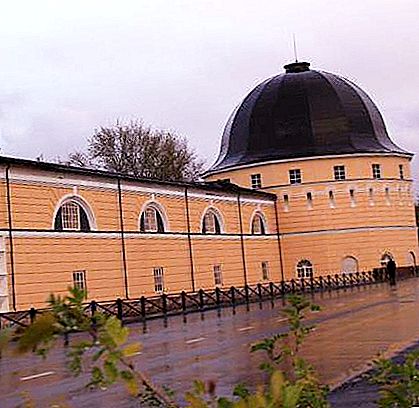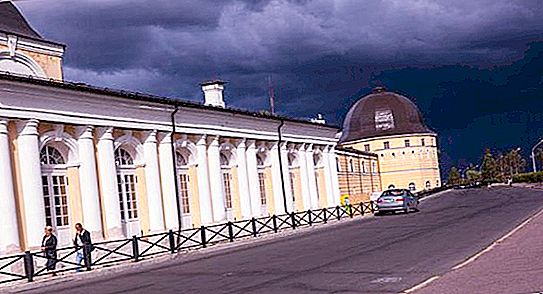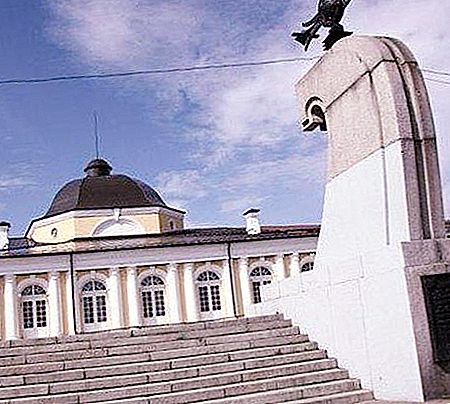The Russian economy in the 17th century was rapidly developing. Then in the Arkhangelsk port, foreign trade was confidently going on. More than half of foreign trade transactions were made in it. The city represented the "face" of the country before the Western European states. Arkhangelsk needed magnificent buildings with magnificent facades.
Seating yards of the northern city became not only a pleasant and convenient place for foreign and Russian merchants, but also performed a protective function. Nowadays, they are recognized as unique monuments of Russian stone architecture dating back to the 17th century.
History of creation
In 1667, Tsar Alexei Mikhailovich issued a decree ordering the start of construction on an area of almost 9 hectares of a grandiose stone structure in Arkhangelsk. Drawings of the architectural complex were city planners P.G. Marcelis and V. Sharf.

In those days, a city built of wood constantly blazed in fires. Fire destroyed a huge number of buildings and walls, so they decided - to build living rooms from stone. Arkhangelsk, whose history is rich, was not easy for buildings for trade, it built a real fortress with two guest complexes: Russian and German.
A square with a huge square in the center formed the Russian and German courtyards. The complex was equipped with elements of military defensive significance. As a result, courtyards connected by walls, towers and other structures, surrounded by moats, turned into a powerful stone city-fortress.
The construction of the grandiose fortress lasted 16 years (1668-1684). In 1693, Peter I arrived in Arkhangelsk. Seating yards of the city, seen by him for the first time, enthralled him. Their decline will begin in the XVIII century, when foreign economic activity will be transferred to St. Petersburg. The northern shopping center, being unclaimed, will begin to crumble.
Restoration of Gostiny Dvor
In 1770, after the building was declared emergency, its immediate reconstruction began. The dilapidated sections of the Russian compound were dismantled, the brick and lime slabs were sent for restoration. The German courtyard and the stone city-fortress were almost completely removed. The ruins of the German farmstead existed until the 20th century. At the beginning of the century they were completely dismantled.
In the 70s of the XVIII century, the facade of the building was given the classic shape characteristic of the architecture of that era. In 1788, a one-story Exchange with a turret and a front facade rose above the new foundation. Special order furniture was arranged in the exchange room, fireplaces were arranged. In the navigation season, a flag fluttered above the turret and a lantern burned.
Instead of the Stone Town, warehouses were built with a height of 2 floors for wine and salt. A tower was attached to the storage rooms. The project for their construction was developed by architect M. Berezin. He planned to attach a similar building to the North Tower. But the meager financing and lack of building materials forced the architect to suspend construction. Only in 1809 with great difficulty was it possible to build the first floor of salt warehouses without a tower.

Having lost the original complex with powerful fortress walls, Arkhangelsk received the Gostiny Dvory, but not in its original form. After the middle of the twentieth century, the city lost most of the Russian court. From it there were only buildings on the west side, facing the embankment of the Northern Dvina.
Despite this, the architectural complex with the preserved buildings: the Russian Gostiny Dvor, a tower on the north side, an exchange, a chauffeur and salt warehouses located in the city center near the embankment, looked majestic.
Gostiny Dvor during the Great Patriotic War
Having lost its military significance, the complex was reorganized by the townspeople for peaceful purposes. The city council, court, customs were transferred to it. Shops were opened in its premises. In the Great Patriotic War, the basements of salt depots were used as bomb shelters. Local residents took refuge in them from air raids.
In addition, during the war years, premises for the White Sea Flotilla and communications center were allocated in the buildings of the complex. The tasks of the military unit included ensuring communication with the Arctic and the Kara Sea.
Museum in Gostiny Dvor
Since 1981, the historical monument has been taken over by the city museum of local lore. Gostiny Dvory (Arkhangelsk), more precisely, their preserved parts, began to slowly restore. The restoration plan included the restoration of the Russian courtyard, towers and buildings on the north side, salt warehouses. After the restoration work was completed in 2010, Arkhangelsk found a simplified version of the magnificent architectural ensemble. Gostiny Dvor now is a cultural and scientific-educational center of the city.

In its halls, interesting expositions have been created telling about the monuments of material and spiritual culture of the northern region. The museum constantly exhibits several exhibitions: on the cultural and historical heritage of Pomerania and Russian northern monasteries. Two chambers are given under the exposition devoted to M.V. Lomonosov. In one, exhibits about the small homeland of a brilliant scientist of Russia are collected, in the second a laboratory is created.




